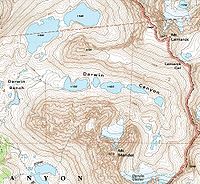
Paternoster lake
Encyclopedia

Glacial lake
A glacial lake is a lake with origins in a melted glacier. Near the end of the last glacial period, roughly 10,000 years ago, glaciers began to retreat. A retreating glacier often left behind large deposits of ice in hollows between drumlins or hills. As the ice age ended, these melted to create...
s connected by a single stream
Stream
A stream is a body of water with a current, confined within a bed and stream banks. Depending on its locale or certain characteristics, a stream may be referred to as a branch, brook, beck, burn, creek, "crick", gill , kill, lick, rill, river, syke, bayou, rivulet, streamage, wash, run or...
or a braided stream system. The name comes from the word Paternoster, another name for the Lord's Prayer
Lord's Prayer
The Lord's Prayer is a central prayer in Christianity. In the New Testament of the Christian Bible, it appears in two forms: in the Gospel of Matthew as part of the discourse on ostentation in the Sermon on the Mount, and in the Gospel of Luke, which records Jesus being approached by "one of his...
derived from the Latin
Latin
Latin is an Italic language originally spoken in Latium and Ancient Rome. It, along with most European languages, is a descendant of the ancient Proto-Indo-European language. Although it is considered a dead language, a number of scholars and members of the Christian clergy speak it fluently, and...
words for the prayer's opening words, "Our Father"; Paternoster lakes are so called because of their resemblance to rosary
Rosary
The rosary or "garland of roses" is a traditional Catholic devotion. The term denotes the prayer beads used to count the series of prayers that make up the rosary...
beads, with alternating prayer beads
Prayer beads
Prayer beads are used by members of various religious traditions such as Roman Catholicism, Orthodox Christianity, Anglicanism, Islam, Hinduism, Buddhism, Sikhism and Bahá'í Faith to count the repetitions of prayers, chants or devotions, such as the rosary of Virgin Mary in Christianity and dhikr ...
connected by a string or fine chain.
Paternosters occur in alpine valley
Valley
In geology, a valley or dale is a depression with predominant extent in one direction. A very deep river valley may be called a canyon or gorge.The terms U-shaped and V-shaped are descriptive terms of geography to characterize the form of valleys...
s, climbing one after the other to the valley's head, called a corrie
Cirque
Cirque may refer to:* Cirque, a geological formation* Makhtesh, an erosional landform found in the Negev desert of Israel and Sinai of Egypt*Cirque , an album by Biosphere* Cirque Corporation, a company that makes touchpads...
, which often contains a cirque
Cirque (landform)
thumb|250 px|Two cirques with semi-permanent snowpatches in [[Abisko National Park]], [[Sweden]].A cirque or corrie is an amphitheatre-like valley head, formed at the head of a valley glacier by erosion...
lake. Paternoster lakes are created by terminal moraines, or rock dams, that are formed by the advance and subsequent upstream retreat and melting of the ice. The local variation in rock types can also be a factor in creating these lakes. A glacier encountering weaker rock at its base, will be able to erode deeper than when it experiences harder, less erodible rocks. The result of this is the formation of lakes where the weaker rocks once were.
Excellent examples of this occur in California's
California
California is a state located on the West Coast of the United States. It is by far the most populous U.S. state, and the third-largest by land area...
Sierra Nevada, where many stream courses above 3000 m in altitude contain paternoster lakes.
Glacier National park provides another example of paternoster lakes. Five lakes in a row; Lake Shelbourne, Swiftcurrent Lake, Lake Josephine, Grinnel lake, and Upper Grinnel Lake all form a nice "rosary" that has produced some spectacular photographs. The U shape of the valley confirms that it was formed by a glacier long ago, as opposed to a V shaped valley cut by a river.
More good examples of paternoster lakes can be found in Waterton Lakes National Park, Canada. The three Carthew lakes are in a hanging cirque, reflecting their glacial origins, with Anderson Lake lower in elevation but still clearly part of this paternoster lake procession.
Another good example can be found in Yoho National Park, Canada. Lake OHara, Lake Oesa, and the large pools in the stream that connect the two give a total of five stair-stepped lakes/ponds. The presence of a rock glacier in the area points strongly to the glacial origins of this chain of lakes.

